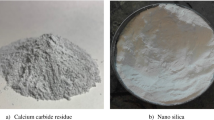Abstract
The corrosion of reinforced concrete that is exposed to chloride corrosive environment reduces the effective life of concrete structures. The response surface method is based on the central composite design and is used to optimize the relationship among weight loss percentage, additive material percent, concrete cover and water-to-cement ratio. In this research, reinforced concretes made with independent variables, which include additive materials, such as glass, microsilica, and limestone powder, various concrete covers on steel bar and water-to-cement ratios. All samples are exposed to a 3.5 wt% NaCl corrosive environment for 180 days. Experimental methods are used to determine the corrosion of reinforced concrete using the weight loss percentage of steel bar, the chloride penetration rate in reinforced concrete, X-ray diffraction and scanning electron microscope of the steel bar. The result indicates that the least penetration of chloride occurs in reinforced concrete with 10% microsilica powder, 8-cm concrete cover and a water-to-cement ratio 0.45 with superplasticizer. The Minitab software with the response surface method model is used to determine the significance of the independent variables, and their interactions are tested by the variance analysis. The equation among weight loss percentage and independent variables with response surface method model is optimized. The response surface model shows an almost well-optimized performance with R2 (90%) for variables such as weight loss percentage of the steel bar and independent variables.










Similar content being viewed by others
References
Angst UM, Elsener B, Larsen CK (2011) Chloride induced reinforcement corrosion: electrochemical monitoring of initiation stage and chloride threshold values. Corros Sci 53:1451–1464
Brenna A, Beretta S, Bolzoni F (2017) Effects of AC-interference on chloride—induced corrosion of reinforced concrete. Constr Build Mater 137:76–84
Dodds W, Christodoulou C, Goodier C (2017) Durability performance of sustainable structural concrete: effect of coarse crushed concrete aggregate on rapid chloride migration and accelerated corrosion. Constr Build Mater 155:511–521
Dousti A, Rashetnia R, Ahmadi B (2013) Influence of exposure temperature on chloride diffusion in concretes incorporating silica fume or natural zeolite. Constr Build Mater 49:393–399
Farahani A, Taghaddos H, Shekarchi M (2015) Prediction of long—term chloride diffusion in silica fume concrete I a marine environment. Cement Concrete Compos 59:10–17
Guzman S, Galvez JC (2017) Modelling of concrete cover cracking due to non—uniform corrosion of reinforcing steel. Constr Build Mater 155:1063–1071
Jalal M, Pouladkhan A, Har OF (2015) Comparative study on effects of Class F fly ash, nano silica and silica fume on properties of high performance self compacting concrete. Constr Build Mater 94:90–104
Jiang G, Keller J, Bond PL (2016) Predicting concrete corrosion of sewers using artificial neural network. Water Res 92:52–60
Jin S, Yang H, Hwang J (2016) Corrosion behavior of steel in CAC-mixed concrete containing different concentrations of chloride. Constr Build Mater 110:227–234
Kayali O, Zhu B (2005) Corrosion performance of medium—strength and silica fume high—strength reinforced concrete in a chloride solution. Cement Concr Compos 27:117–124
Li F, Xiaoya L, Liu Z (2017) Corrosion of anchorage head system of post-tensioned prestressed concrete structures under chloride environment. Struct Concrete J 18:902–913
Ming J, Shi J, Sun W (2018) Effect of mill scale on the long—term corrosion resistance of a low—alloy reinforcing steel in concrete subjected to chloride solution. Constr Build Mater 163:508–517
Miranda JM, Cobo A (2007) Otero E. Limitations and advantages of electrochemical chloride removal in corroded reinforced concrete structures. Cement Concr Compos 37:596–603
Muthulingam S, Rao B (2015) Non-uniform corrosion states of rebar in concrete under chloride environment. Corros Sci 93:267–282
Rezaifar O, Hasanzadeh M, Gholhaki M (2016) Concrete made with hybrid blends of crumb rubber and metakaolin: optimization using response surface method. Constr Build Mater 123:59–68
Rivera-corral JO, Fajardo G, Arliguie G (2017) Corrosion behavior of steel reinforcement bars embedded in concrete exposed to chlorides: effect of surface finish. Constr Build Mater 147:815–826
Rooholamini H, Hassani A, Aliha MRM (2018) Evaluating the effect of macro—synthetic fibre on the mechanical properties of roller-compacted concrete pavement using response surface methodology. Constr Build Mater 159:517–529
Sabour M, Dezvareh G, Bazzazzadeh R (2019) Corrosion prediction using the weight loss model in the sewer pipes made from sulfur and cement concretes and response surface methodology (RSM). Constr Build Mater 199:40–49
Shaheen F, Pradhan B (2015) Effect of chloride and conjoint chloride—sulfate ions on corrosion of reinforcing steel in electrolytic concrete powder solution (ECP). Constr Build Mater 101:99–112
Valipour M, Pargar F, Shekarchi M (2013a) Comparing a natural pozzolan, zeolite, to metakaolin and silica fume in terms of their effect on the durability characteristics of concrete: a laboratory study. Constr Build Mater 41:879–888
Valipour M, Pargar F, Shekarchi M (2013b) In situ Study of chloride ingress in concretes containing natural zeolite, metakaolin and silica fume exposed to various exposure conditions in a harsh marine environment. Constr Build Mater 46:63–70
Wang W, Lu C (2018) Time-varying law of rebar corrosion rate in fly ash concrete. J Hazard Mater 360:520–528
Author information
Authors and Affiliations
Corresponding author
Rights and permissions
About this article
Cite this article
Pakshir, M., Haghbin, A. & Haghbin, M. Using the Response Surface Method to Optimize Weight Loss of Steel Bar in Concrete Exposed to Chloride. Iran J Sci Technol Trans Civ Eng 45, 561–571 (2021). https://doi.org/10.1007/s40996-020-00501-x
Received:
Accepted:
Published:
Issue Date:
DOI: https://doi.org/10.1007/s40996-020-00501-x



